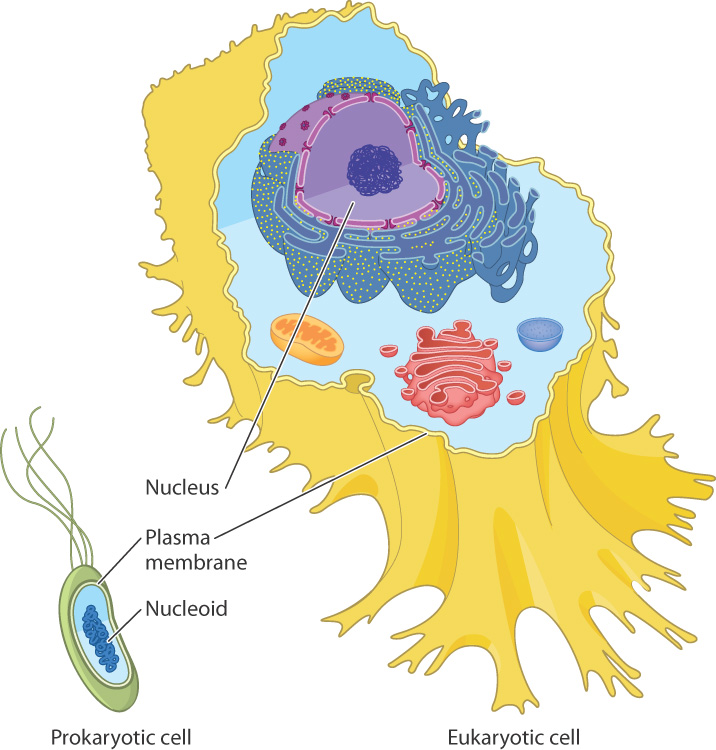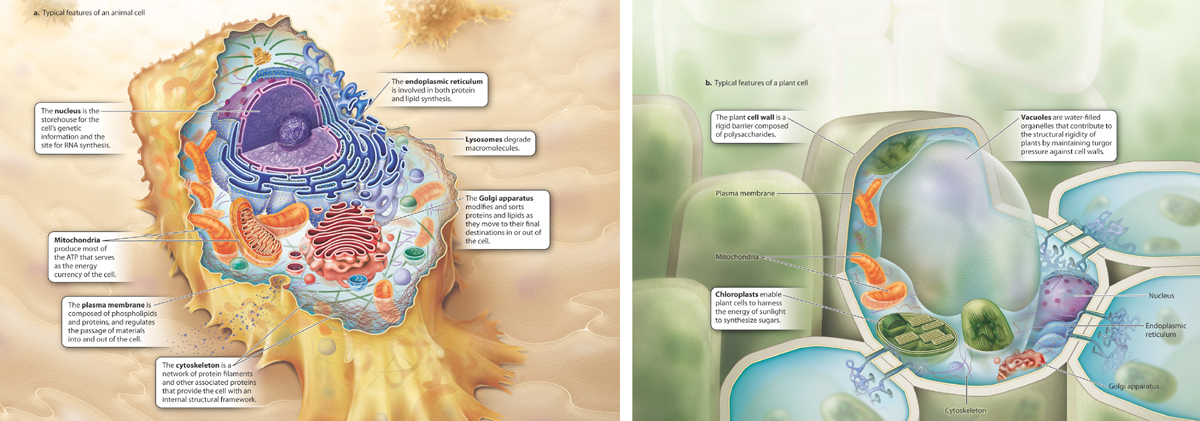5.3 THE INTERNAL ORGANIZATION OF CELLS
In addition to the plasma membrane, many cells contain membrane-bound regions within which specific functions are carried out. Such a cell can be compared to a large factory with many rooms and different departments. Each department has a specific function and internal organization that contribute to the overall "life" of the factory. In this section, we give an overview of two broad classes of cells that can be distinguished by the presence or absence of these membrane-enclosed compartments.
5.3.1 Eukaryotes and prokaryotes differ in internal organization.

All cells have a plasma membrane and contain genetic material. In some cells, the genetic material is housed in a membrane-bound space called the nucleus. Cells can be divided into two classes based on the presence or absence of a nucleus (Chapter 1). Prokaryotes, including bacteria and archaea, lack a nucleus; eukaryotes, including plants, animals, fungi, and protists, have a nucleus (Fig. 5.16).
Although the two groups are defined by the presence or absence of a nucleus, they differ in many other aspects as well. For example, we saw in Chapter 3 that promoter recognition during transcription is different in prokaryotes and in eukaryotes. In addition, there are differences in the specific types of lipid that make up their cell membranes. In mammals, as we have seen, cholesterol is present in cell membranes. Cholesterol belongs to a group of chemical compounds known as sterols, which are molecules containing a hydroxyl group attached to a four-ringed structure. In eukaryotes other than mammals, diverse sterols are synthesized and present in cell membranes. Most prokaryotes do not synthesize sterols, but some synthesize compounds called hopanoids. These five-ringed structures are thought to serve a function similar to that of cholesterol in mammalian cell membranes. Additional differences between prokaryotes and eukaryotes are discussed below.
5.3.2 Prokaryotic cells lack a nucleus and extensive internal compartmentalization.
Prokaryotes do not have a nucleus; that is, there is no physical barrier separating the genetic material from the rest of the cell. Instead, the DNA is concentrated in a discrete region of the cell interior known as the nucleoid. Bacteria often contain additional small circular molecules of DNA known as plasmids that carry a small number of genes. Plasmids are commonly transferred between bacteria through threadlike, hollow structures known as pili (singular, pilus), which extend from one cell to another. Genes for antibiotic resistance are commonly transferred in this way, which accounts for the quick spread of antibiotic resistance among bacterial populations.
Although the absence of a nucleus is a defining feature of prokaryotes, other features also stand out. For example, prokaryotes are small, just 1–2 micrometers (1/1,000,000 of a meter) in diameter or smaller. By contrast, eukaryotic cells are commonly much larger, on the order of 10 times larger in diameter and 1000 times larger in volume. The small size of prokaryotic cells means that they have a relatively high ratio of surface area to volume, which makes sense for an organism that absorbs nutrients from the environment. In other words, there is a large amount of membrane surface area for absorption relative to the volume of the cell that it serves. In addition, most prokaryotes lack the extensive internal organization characteristic of eukaryotes.
5.3.3 Eukaryotic cells have a nucleus and specialized internal structures.
Eukaryotes are defined by the presence of a nucleus, which houses the vast majority of the cell's DNA. The nuclear membrane allows for more complex regulation of gene expression than is possible in prokaryotic cells. In eukaryotes, DNA is transcribed to RNA inside the nucleus, but the RNA molecules carrying the genetic message travel from inside to outside the nucleus, where they instruct the synthesis of proteins.
Eukaryotes have a remarkable internal array of membranes. These membranes define compartments, called organelles, that divide the cell contents into smaller spaces specialized for different functions. Fig. 5.17a shows a typical animal cell (a macrophage) with various organelles. The endoplasmic reticulum (ER) is involved in the synthesis of proteins and lipids. The Golgi apparatus modifies proteins and lipids produced by the ER and acts as a sorting station as they move to their final destinations. Lysosomes contain enzymes that break down macromolecules such as proteins, nucleic acids, lipids, and complex carbohydrates. Mitochondria (singular, mitochondrion) are specialized organelles that harness energy for the cell. Many cell membranes that define these organelles are also associated with a protein scaffold called the cytoskeleton that helps cells to maintain their shape and serves as a network of tracks for the movement of substances within cells. Some cells even move with the help of the cytoskeleton.

Fig. 5.17b shows a typical plant cell. In addition to the organelles described above, plant cells have a cell wall outside the plasma membrane, vacuoles specialized for water uptake, and chloroplasts that convert energy of sunlight into chemical energy.
The entire contents of a cell other than the nucleus make up the cytoplasm. The region of the cell inside the plasma membrane but outside the organelles is referred to as the cytosol. This is the jelly-like internal environment surrounding the organelles.
In the next two sections, we consider these organelles in more detail, focusing on the role of membranes in forming distinct compartments within the cell. The cytoskeleton is discussed in Chapter 10.